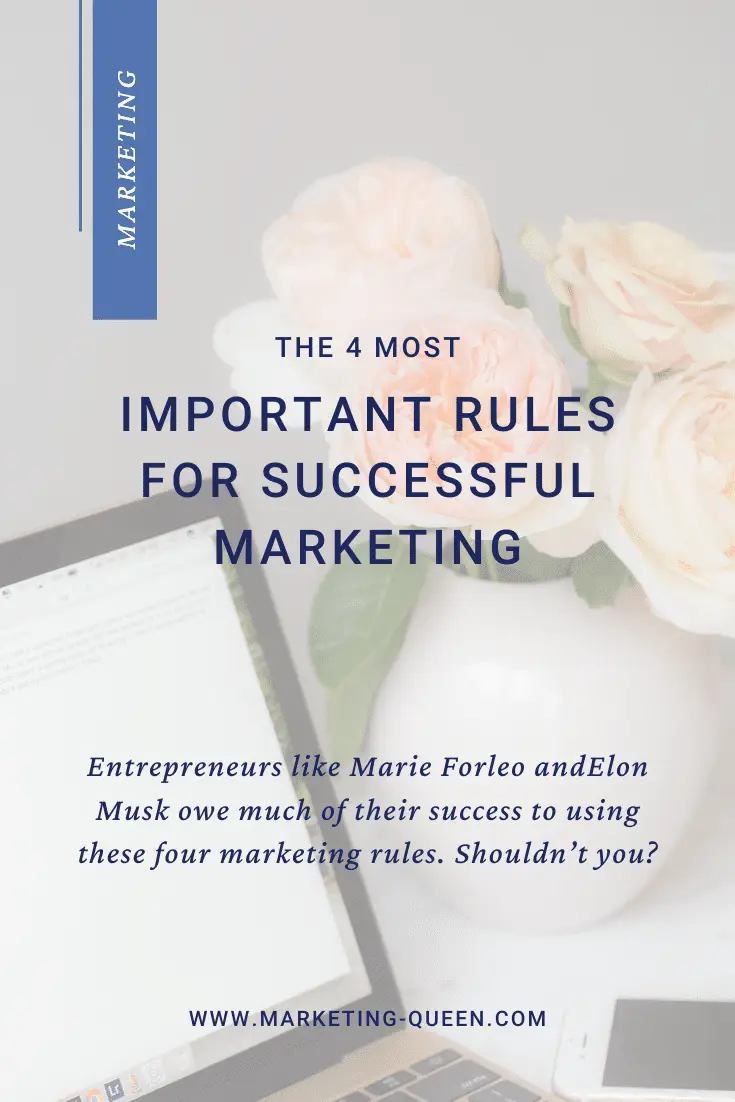Believe it or not, there are really only FOUR rules for being successful in marketing.
These four rules are behind the marketing success of big-name entrepreneurs like Elon Musk and Marie Forleo. You know who else uses them? Successful local businesses, including your competition.
They’re so successful with these four rules because they apply them to every single marketing channel their brand uses. For you, this means no piece of marketing is too small. You want to think about:
- Your logo and brand color palette
- Your interactions with customers on your Facebook page
- The photos and stories you share on Instagram
- The small details on every piece of paper you give your clients, including contracts
- The in-person and over-the-phone conversations you have with prospects and clients
- Advertisements, both print (postcards, brochures) and digital (Google and Facebook ads)
- And many, many, many more
Basically, each and every detail of your brand that “touches” your clients or potential clients is marketing. Customer service? That’s marketing. Project management? That’s marketing, too.

Each of these marketing touchpoints has a significant impact on your business’s success.
Now here’s the good news:
- The rules are easy. (Really!)
- The rules are fun. (I’ll show you how!)
Keep this in mind as you read the four rules, because you’ll probably start to feel excited about implementing them.
The #1 Rule for Marketing Success: Commitment
Are you committed to your brand’s success?
If you’re reading this, you must be pretty committed. But you’ll have to take it one step further and commit to your marketing as an ongoing process.
As long as you’re in business, you’ll always have two businesses. The first is your actual brand and what you do. The second is marketing that first business.
You’ll also need to commit to every piece of marketing individually. If you invest any time (or dollar$$$) into a marketing touchpoint, you need to give it enough time to thrive. Oftentimes, a good rule of thumb for commitment is at least one quarter of the year.
Let’s use the example of wedding designer Sarah (I made her up just now). If Sarah decides to make Instagram microblogging a priority in her content marketing, she must commit to doing it consistently before labeling it a success (or not a success).

The seasonal nature of the wedding industry provides a unique marketing challenge for Sarah and others like her. If Sarah tests a marketing experiment in the second quarter, she can’t decide if it will work in the first quarter. Why not? More brides are seeking her services in the first quarter, so they’ll be hungrier for content. But in the second quarter, fewer people are looking for this. So, Sarah will need to commit for a full year so she can compare first quarter in year one to first quarter in year two.
Important note: Committing does not have to be rigid. Tweaking is always permitted when necessary. See Rule #2.
The bottom line: you’ll need to give each new marketing touchpoint between 6 to 12 months to mature before you can declare it a success.
The #2 Rule for Marketing Success: Creativity
I usually call this the Fun Rule. Because this is where you get to enjoy the marketing process. You get to use your passion to be creative.
Sometimes clients tell me they’re not creative. #RealTalk: You wouldn’t be in the business of creating stunning, unforgettable wedding days if you weren’t creative!
Say this aloud with me: “I am super creative!” Really, say it aloud (and the louder the better). Who cares who’s listening? “I AM SUPER CREATIVE!”
But maybe you have a big bad case of perfectionism. Unfortunately, perfectionism and creativity don’t play nicely in the sandbox together. It’s hard to create something when you want it to be perfect from the get-go.
However, perfectionism isn’t always a liability. In fact, it’s why you’re so good at helping brides realize their vision for a perfect wedding.

Can you do both: be creative and be perfect? Yes! (Setting aside the fact that there is no such thing as perfect…) You just have to think of creative as happening before perfect.
Let’s see how this would work for Sarah (our wedding designer).
- Creative phase: this is the idea generation or brainstorming phase. For our wedding design consultant, this looks like coming up with many ideas for a client’s wedding. Not all of them will be viable or maybe even good. But: you have to get the bad ideas out in order to get the good ideas to come out.
- Perfecting-it phase: once you’ve chosen your creative direction, it’s perfectionism’s turn. This is where your perfectionism can be useful. It can keep everything consistent and on-message for your brand. (This is how you can quiet that perfectionist voice: tell it to wait its turn.)
We can apply that same process to something like blogging:
- Creative phase: coming up with many topics that would benefit your audience and writing your first drafts. Just get the words down on paper.
- Perfecting phase: this is when you edit your first draft. Keep in mind that done is always better than perfect – and you’ll want to go back and update your high-performing posts with new information to keep them relevant.
Being creative requires being fluid – that’s why we talk about “letting the creative juices flow.” Fluidity really helps with perfectionism. Don’t just let your creative juices flow, let them FLOOD your need for perfectionism in phase one. Phase two – edit and perfect (verb here!). This is on-going from pre-publish all the way through to post-publish. Cliche but ‘perfection is the journey, not the destination.’
And most importantly be open to trial-and-error. See how your audience responds and make tweaks where necessary.
The bottom line: your business has a brand – the brand represents the business’ personality. Show off your personality, and be creative!
The #3 Rule for Marketing Success: Measure
In Rule #2 I said, “See how your audience responds and make tweaks where necessary (keep perfecting it).”
However, you can’t do this until you have an exact way to measure the “response.” And if you can’t measure the response, you won’t know where to tweak.
For example, maybe Sarah’s Uncle Leonard writes a really long comment on one of her blog posts disagreeing with everything she says. (Sounds like Uncle Leonard is kind of a jerk.) Should Sarah change her blog post based on Uncle Leonard’s shade? Probably not. He’s just one person, who’s not her target audience, and who’s still mad Sarah didn’t go into the family woodworking business.
Since Sarah won’t change her blog post based on Uncle Leonard’s response, neither should you. So let’s find the measurement you need.
Google Analytics (GA) is by far the best (and most popular) tool for doing that. Most of your marketing should occur on your website, and GA will give you a lot of rich information about how much time your visitors spend on your site, which pages make them leave, and how many people visit your contact form and then actually fill it out.
Related: Four Basic Stats to Watch in Your Google Analytics Dashboard
You’ll need these numbers before you can make any tweaks to your marketing. That’s the beauty of GA – you don’t have to guess at what isn’t working and hope for the best.
The bottom line: every time you publish anything, ask yourself: “What do I want this piece of content to make people do? How can I tell if they’re doing it?”
The #4 Rule for Marketing Success: Consistency
Consistency is the engine that makes rules #1, #2, and #3 work. Your commitment and creativity, your metrics and tweaks – all of that means nothing if you aren’t consistent.
For marketing success, you have to be consistent in terms of alignment and in terms of time. For alignment, this means keeping your messaging consistent. If Sarah’s wedding design business caters to a wealthy clientele, she wouldn’t want to share photos of her cats sleeping on her bed (no matter how cute they are).
Sophisticated brides seeking Sarah will see the cat photos and get the wrong idea about Sarah’s business. “What do sleeping cats have to do with my wedding? Does she even know what she’s doing?” That’s the sound of a lost sale.
Time and timing is the other facet of consistency. You can’t produce one marketing touchpoint and then hope for the best. Launching a new website is exciting, but you can’t relax and wait for people to find you. You have to keep getting your website in front of people’s eyeballs. You can’t write one newsletter and expect it to produce clients for you for a year. No, you need to write a newsletter on a consistent, regular basis to stay top-of-mind with your leads and prospects.
The bottom line: you need to be consistent with your marketing messages and frequency in order to achieve success.
The 4 Rules for Marketing Success in Two Words
Now you know the four major rules of successful marketing.
And they can be summed up in two words: common sense. Because when you read the rules you think “oh yes! That’s right!”
For example, couples are getting engaged and married every single day! So Sarah’s audience looks different every day as it grows and shrinks. She’s in a unique position because she can share the same content annually with very little chance of having the same people see it again. Her opinions and thoughts will always be new and fresh for her audiences.
This is called rebroadcasting your marketing. I tell my clients, “Just because you told folks in April the leftmost fork is for salad doesn’t mean your (mostly new) audience in August will have heard it! It’s good to repeat your message, as long as you do it strategically.”
Basically, don’t let your content die the day after you publish it. When you think about it, it’s just common sense that you’ll want to keep a post you worked hard on alive.
There are many other important marketing rules, but these 4 are bae (before anything else). You’ve got the tools to make the judgment call. It’s all from within you…trust your gut!
















